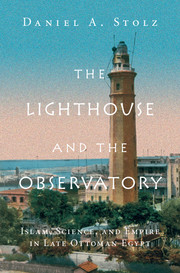Book contents
- The Lighthouse and the Observatory
- Science in History
- The Lighthouse and the Observatory
- Copyright page
- Dedication
- Contents
- Figures
- Tables
- Acknowledgments
- Note on Chronology and Transliteration
- Abbreviations
- Introduction: Astronomy, Empire, and Islamic Authority at the End of Days
- Part I Geographies of Knowledge
- Part II Objects of Translation
- Part III Islam, Science, and Authority
- Conclusion: Astronomy, the State, and Islamic Authority at the End of the Day
- Appendix: Muhammad al-Khudari al-Dimyati’s Introduction to his Commentary on the Brilliancy of the Solution of the Seven Planets
- Bibliography
- Index
- References
Bibliography
Published online by Cambridge University Press: 21 December 2017
- The Lighthouse and the Observatory
- Science in History
- The Lighthouse and the Observatory
- Copyright page
- Dedication
- Contents
- Figures
- Tables
- Acknowledgments
- Note on Chronology and Transliteration
- Abbreviations
- Introduction: Astronomy, Empire, and Islamic Authority at the End of Days
- Part I Geographies of Knowledge
- Part II Objects of Translation
- Part III Islam, Science, and Authority
- Conclusion: Astronomy, the State, and Islamic Authority at the End of the Day
- Appendix: Muhammad al-Khudari al-Dimyati’s Introduction to his Commentary on the Brilliancy of the Solution of the Seven Planets
- Bibliography
- Index
- References
- Type
- Chapter
- Information
- The Lighthouse and the ObservatoryIslam, Science, and Empire in Late Ottoman Egypt, pp. 282 - 306Publisher: Cambridge University PressPrint publication year: 2018



